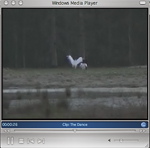Today's Report Includes:
- Celebrating Tom Stehn: Honored 2008 Recovery Champion >>
- Journal Topic: Why is Crane Population Growth So Slow? >>
-
Links: This Week's Crane Resources >>
Photo
USFWS |
This week we take time to celebrate Tom Stehn, who has inspired, entertained, and shared news with us this spring — and every spring since 1995. It's no surprise that Tom's WCEP partners call him the "ultimate Whooper guru."
Tom has been a contributing scientist to Journey North every year since 1995. He reported 132 Whooping cranes in Texas that winter. Under his leadership, the world's last remaining natural flock of migratory whoopers grew to 270 arrivals this winter. For his years of dedication and success, Tom has earned an award called 2008 Recovery Champion. We are thrilled and proud to say congratulations!
This prestigious award comes from the United States Fish and Wildlife Service (USFWS). It honors U.S. Fish and Wildlife Service staff and their partners whose work is advancing the recovery of endangered and threatened species in the United States. Before you dig in to see what Tom teaches us this week, we invite you to read the USFWS tribute to Tom (scroll to Region 2): 2008 Recovery Champions.
 |
Tom
Stehn carries a wild juvenile crane too weak to stand to veterinarian
help in Port Lavaca, TX in 2009. |
Here's another happy topic. Did you know that Whooping cranes do more than just fly? They also dance up a storm, especially in springtime. When young cranes dance, they build social and physical skills. Single birds dance to court each other. And pairs dance to prepare for breeding. The pair may sing a duet together as they dance, with a unison call. Sometimes cranes just dance for the fun of it!
In this lesson, watch an amazing courtship dance in the video clip. Next, study the dance steps, then feel the joy of moving like a crane with our directions!

Drawings from Allen, R.A. 1952. The Whooping Crane. Research Report No. 3 of the National Audubon Society. With thanks to Brian Johns, Canadian Wildlife Service.
Last week you learned about research efforts about the limited breeding success of the new Eastern flock. Everyone is hoping for chicks from these nests! But did you know that it’s impossible for Whooping crane population to grow very fast — even under the best conditions? What reasons does biologist Tom Stehn give to explain this? Read Tom's lesson and then tackle the journal question:
- If only one chick usually survives, why do Whooping cranes lay that second egg? What reasons can you think of why a second egg might sometimes be important?
List your ideas in your journal. >>
The Next Whooping Crane Migration Update Will Be Posted on May 1, 2009.









